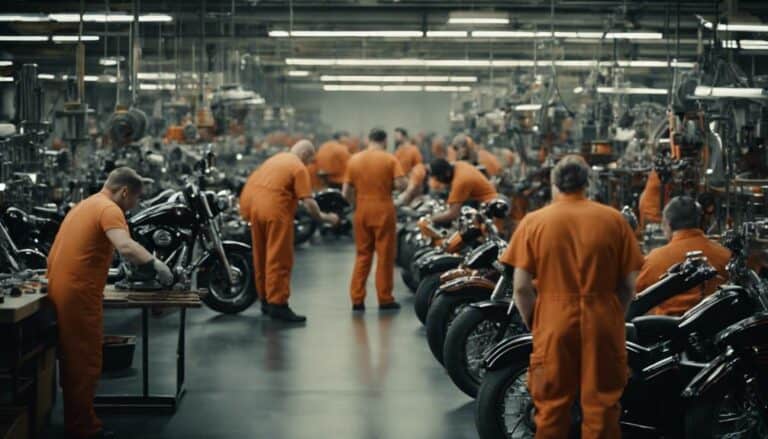When it comes to Harley Davidson motorcycles, you might wonder where they are assembled.
The assembly of these iconic bikes takes place primarily in the United States, but there's more to the story than just that.
As you explore the intricate web of assembly plants, sourcing strategies, and the impact of globalization on this renowned brand, you'll uncover a fascinating journey that goes beyond borders and into the future of motorcycle manufacturing.
Key Takeaways
- Harley Davidson motorcycles are primarily assembled in the U.S. at plants in Wisconsin and Pennsylvania.
- International assembly facilities are located in Brazil, India, and Thailand for different models.
- Components are globally sourced, with parts from countries like Taiwan, Japan, Italy, and Mexico.
- The company aims for a balanced manufacturing presence globally to manage costs, quality, and market demands.
Assembly Plants in the U.S
The assembly plants in the U.S. where Harley Davidson motorcycles are manufactured play a crucial role in serving American customers efficiently. With facilities located in Wisconsin and Pennsylvania, Harley-Davidson emphasizes the importance of keeping production within the United States to cater to its domestic market. While the Kansas City plant ceased operations in 2019, the focus remains on the two existing plants to meet the demand for these iconic American-made motorcycles.
In Wisconsin and Pennsylvania, skilled workers meticulously assemble various models of Harley Davidson motorcycles, ensuring that each bike meets the company's high standards for quality and craftsmanship. These assembly plants not only provide jobs in the local communities but also contribute to the legacy of American manufacturing in the motorcycle industry.
When you ride a Harley Davidson motorcycle assembled in these U.S. facilities, you're not just experiencing the thrill of the open road; you're also supporting a tradition of American craftsmanship and ingenuity that runs deep in the veins of Harley-Davidson.
International Assembly Facilities
How are Harley Davidson motorcycles assembled in various international facilities to optimize production and manage costs effectively?
Harley Davidson has strategically placed international assembly facilities in countries such as Brazil, India, and Thailand. The decision to establish a plant in Thailand was driven by the need to navigate increasing import costs to Europe efficiently. By leveraging global supply chains, Harley-Davidson can balance production costs and tariffs effectively.
This approach also allows the company to cater to specific market demands by assembling different models in various international facilities. While the iconic motorcycles are synonymous with being 'Made in America,' the use of American parts in these international assembly plants ensures a consistent standard of quality across the globe.
These facilities play a crucial role in mitigating the impact of trade disputes and ensuring a steady supply of Harley-Davidson motorcycles to dealerships worldwide, all while maintaining the brand's signature V-twin engines.
Components Sourcing and Manufacturing
To optimize production and manage costs effectively, Harley Davidson strategically sources components from various countries like Taiwan, Japan, Italy, Germany, and Mexico for their motorcycles assembled in international facilities.
The assembly process integrates parts from around the world – brakes and clutches from Italy, engine pistons from Austria, and bike suspensions from Japan. Electronic components, crucial for modern Harley Davidson motorcycles, are sourced from Mexico and China.
While the final assembly primarily takes place in the US, Harley Davidson also operates plants in Thailand, India, and Brazil to streamline their international supply chains. This approach not only ensures a diverse range of high-quality components but also reflects the interconnected nature of modern manufacturing.
Impact of Globalization on Assembly
Assembling Harley Davidson motorcycles involves a complex integration of globally sourced components, showcasing the intricate impact of globalization on the assembly process. Harley-Davidson's assembly strategy revolves around catering to American customers by focusing on the US market while strategically sourcing parts from various countries worldwide. Components like brakes from Italy and engine pistons from Austria are imported to the US for assembly, reflecting the company's globalization approach.
Harley Davidson's production locations are shifting to effectively manage costs and navigate international tariffs, adapting to the changing global trade landscape. This strategy not only ensures the quality and diversity of components but also underscores the brand's commitment to meeting the needs and expectations of American customers. The intricate dance of sourcing components globally and assembling in the US highlights the profound impact of globalization on Harley Davidson's assembly process, shaping the way these iconic motorcycles come together for riders worldwide.
Future Prospects and Expansion
Moving forward, Harley-Davidson's outlook for future prospects and expansion involves a strategic approach to leverage its international manufacturing footprint while maintaining its core assembly operations in the US. The company's expansion into countries like Thailand, India, and Brazil signifies a broader vision for growth and market reach. These shifts in production locations were partly influenced by EU tariffs on US products, prompting Harley-Davidson to adapt its global operations and supply chain to remain competitive. Despite this international presence, Harley-Davidson remains committed to its US assembly operations, recognizing the importance of catering to American customers and preserving its heritage.
Looking ahead, Harley-Davidson aims to balance its manufacturing presence across different regions to mitigate risks and capitalize on diverse markets. By optimizing its international supply chain and production locations, the company can navigate trade challenges more effectively while meeting the demands of a global customer base. With a strategic focus on expansion and innovation, Harley-Davidson is poised to navigate the complexities of the industry while staying true to its roots in the US.
Conclusion
So, now you know where Harley Davidson motorcycles are assembled. Despite their global supply chain, the company is committed to maintaining assembly operations in the US for American customers.
It's ironic how a brand known for its American heritage relies on parts from various countries. As Harley Davidson continues to expand internationally, the 'Made in America' label remains a key focus for its domestic market. The blend of globalization and patriotism is truly a unique aspect of the Harley Davidson brand.

